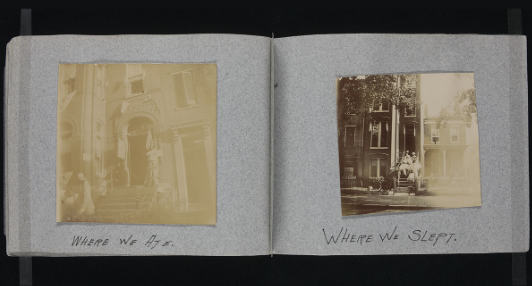Colored Conventions Project

What Did They Eat? Where Did They Stay? Black Boardinghouses and the Colored Conventions Movement
This exhibit prompts us to look beyond the convention hall and to consider a broader spectrum of political engagement encompassing the work of women within home.
Example of a Featured Exhibit.
Colored Conventions Project
Cofounded by Professor P. Gabrielle Foreman, Jim Casey, and Sarah Patterson, the Colored Conventions Project’s creation, vision, and expansion over the years is a testament to the shared work among many groups of people. Its purpose is to bring historical 19th-century Black organizing into the digital sphere, detailing the 1830–Civil War era political meetings held by Black Americans known as the “Colored Conventions,” which brought communities together in a campaign for civil and human rights. The site provides interactive exhibitions of both images and documents to introduce these conventions and educate audiences. Created in partnership with national and local teaching partners and student contributors, these curated exhibits draw from CCP collections to present cultural artifacts and materials related to Black organizing in the nineteenth century.
Through the digitisation speeches, letters and further artifacts written by Black Americans the CCP develops all literary criticism by creating the opportunity for interpretation surpassing traditional white literary criticism. The fact that the CCP centres overlooked and marginalised narratives, means that they create a space for close reading through archival salvage in the digital world. Furthermore, they transform how we teach and learn about this period, bringing the buried history of collective Black organizing to digital life for a new generation of students, scholars, and community researchers.’
The Colored Conventions Project’s focus on education demonstrates their presence within Digital Humanities – as well as their attention on ‘collaboration. In digital humanities, there is a central commitment with combining ‘all types of knowledge building that span education and research’: situated in an ‘intellectual and technologically engaged context that differs from many traditional academic settings. This is what makes archive sites such as CCP so revolutionary: it is a work spanning centuries, with each factor saved for future education. One of their main methodologies is digital platforms and unique interactive exhibits.
This cross-cultural cultivation reflects Digital Humanities position between disciplines and departments, bringing together perspectives that had previously not received enough emphasis – in the sense that The CCP bridges departments – from archival history to digital display – free from the constraints of disciplinary boundaries. This has therefore been described as a ‘curiosity driven site for learning’. It is further held that ‘learning in epistemically and structurally different environments has the potential to change the way we think’ through a ‘deep intellectual-material engagement across disciplines. CCP therefore offers new forms of engagement to navigate history and educate on Black American history in methods previously unseen.
Finally, they centre humanities-based interpretation alongside their digital elements, and the CCP has exemplified postcolonial digital humanities by providing an archival space for Black historical narratives, as in the way that postcolonial digital humanities take the belief that ‘a postcolonial approach requires designing new tools, methods and workflows… to create space for underrepresented communities’. This, therefore, directly intervenes in colonial systems historically marginalising African voices. It is through these ways that the Colored Conventions Project preserves and reanimates a critical chapter of Black History. Moreover, the site represents the potential of digital humanities collaborative efforts to preserve, represent and educate.